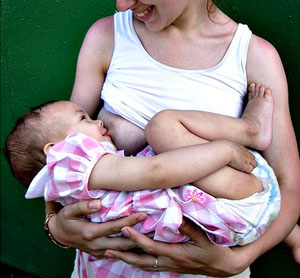A recent study conducted by researchers from Switzerland and the United Kingdom that breastfeeding improves lung function in children at the age of school entry, especially if they were mothers living with asthma, so as published in the journal “American Journal of Respiratory and Critical Care Medicine” the number of the month of Feb. .
The researchers study and analysis of data for 1458 children, born between 1993 and 1997 in the UK, and assessed the duration of breastfeeding and symptoms of breathing and some measurements of lung function such as “FVC” and “” FEV1 at the age of school entry, and the results showed that children born to mothers infected with asthma improved lung function have dramatically when continued breastfeeding for more than six months.
The study added that this is not the findings of other researchers, adding that breastfeeding may have a direct impact in helping the growth of the lungs, and contrary to what came of these results with previous studies that breastfeeding may be harmful to children born to mothers infected with asthma.
and also….
Home Remedies for Breastfeeding
Providing precious moments of bonding between mother and child, the act of breastfeeding is much more than providing nourishment to newborns. Thought a healthier choice for feeding babies, millions of mothers will embrace the emotional and physical challenges of breastfeeding. To make the experience a bit easier, it’s suggested to become more familiar with home remedies for breastfeeding.



COMMON BREASTFEEDING ISSUES
Yes, breast milk is easier for babies to digest than commercial formulas, as it also prevents future food allergies, protects against infections, aids brain development, and encourages the growth of healthy teeth. However, breastfeeding mothers often face an assortment of obstacles and common issues, such as:
• Low Milk Production: A poor diet or medications can lead to low-quality milk or compromised production. Using breast pumps may also slow down milk production, ultimately lowering the amount available for your baby.
• Engorgement: During the first two to three weeks after delivery, some mothers face breast engorgement – when milk excessively fills the breast. Blood and fluid retention add to the overall problem. Women suffering engorgement experience breasts that are hard, tight, tender, full, and tender to touch. The symptoms also make it hard for a baby to latch on and suck.
• Cracked or Sore Nipples [1]: Positioning your baby incorrectly or using damp breast pads can lead to cracked nipples, which can become plagued with redness, irritation, and pain. In some cases, bleeding occurs.
• Plugged Duct: If a baby doesn’t completely empty a breast when feeding, the remaining milk can harden and block the duct. A tight bra can also cause blockage in the ducts. A typical sign of plugged ducts is sore breasts. When left untreated, plugged ducts can turn into mastitis.
• Matitis [2]: When a plugged duct becomes infected, mastitis is the result – causing swollen breasts to fill with bacteria that enter through small cracks found on the nipples. Breasts infected with mastitis are red, painful and secrete pus. Other symptoms include fatigue, vomiting, nausea, and fever.
BREASTFEEDING HOME REMEDIES
If you’ve decided to provide your baby with one of the most natural means of nourishment, prepare yourself for a roller-coaster ride of potential frustration and physical repercussions. To treat common issues that arise, become familiar with the following home remedies for breastfeeding:
a) Vitamin E:
Soothe cracked nipples by applying a small amount of vitamin E oil. After nursing, one of the best ways to treat discomfort is to pierce a vitamin E capsule, squeeze out a drop, and rub into the nipple.
b) Hot Compress:
Sometimes, babies are unable to keep up with a mother’s milk production. When faced with overproduction of breast milk, place a hot, wet compress (or washcloth) on the breast to open ducts and allow milk to flow more freely. Additionally, attempt to nurse your baby more often and for longer periods of time to encourage your baby’s appetite.
c) Frequent Nipple Checks:
Checking your nipples on a daily basis can avoid breastfeeding issues, as well as solve current problems. If you spot dry milk on your nipples, use a cotton ball dipped in warm water to remove residue.
d) Baby Positions:
If you place your little one in different positions during each session of breastfeeding, you can prevent the overuse of ducts.
e) Be Gentle to Nipples:
Contrary to popular belief, manipulating or “exercising” the nipples to “toughen up” the skin can wind up doing more damage than good. Proper placement of your baby helps prevent soreness of the nipples.
f) Tea Bags:
When nipples become sore, apply moistened tea bags to reduce the pain. Choose chamomile to control inflammation of the breast.
g) Olive Oil:
Prevent and treat the cracking, tearing and chapping of nipples by rubbing on a small amount of olive oil during the initial weeks of nurses. ??
h) Avoid Soap:
Using soap to clean your nipples leads to excessive dryness, chaps, and cracks. There is no need to use soap, cologne, deodorant or powder on your nipples or breasts – the small bumps located around the areola actually produce oil that contains a natural antiseptic.
i) Aloe Vera:
Treat sore and cracked nipples to fresh aloe vera gel for healing relief.
j) Cumin:
To increase milk production, mix powdered cumin seed and water together to create a paste that also kills germs found in the region. Gently apply the cumin paste over the breasts.
k) Beta-Carotene:
Nursing mothers should increase their intake of foods to receive a high supply of beta-carotene for energy and immune system support. A couple of suggestions include carrots (especially canned carrot juice), spinach (containing the highest among out of all green vegetables), and apricots (as a fruit or juice).
Resources
[1] http://www.webmd.com/parenting/features/breastfeeding-sore-nipples
[2] http://pediatrics.about.com/od/breastfeeding/a/mastitis.htm
Thanks for installing the Bottom of every post plugin by Corey Salzano. Contact me if you need custom WordPress plugins or website design.



You must log in to post a comment.